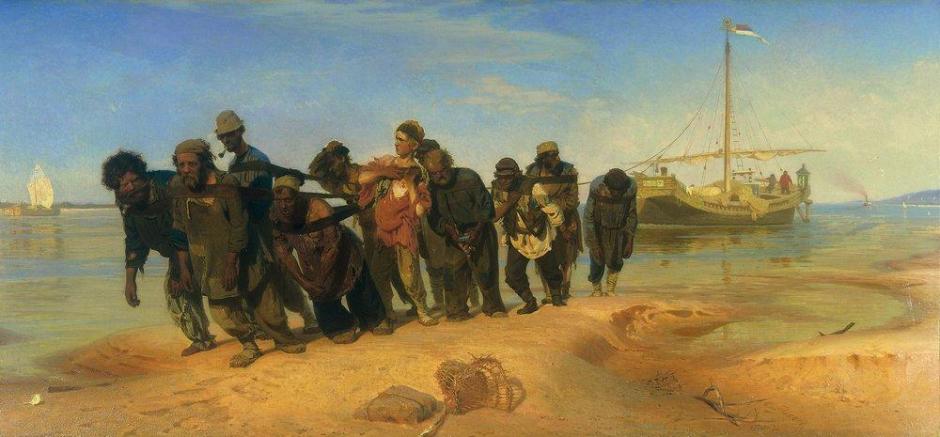No, I’m not about to try to tell you that Ilia Repin is just a Ukrainian painter. What I’d like to do is show how he was more than the Russian painter that he’s normally labelled as.
Ilia Repin, or Ilya Yefimovich Repin, (1844-1930) was born in the town of Chuhuiv, to the south-east of the city of Kharkiv in eastern Ukraine. His father was an itinerant horse-seller who was a veteran of three major wars. Repin was schooled locally, and started his working life as an apprentice to an icon painter. In the autumn of 1863, when he was nineteen, he moved to Saint Petersburg to try to gain entry to the Imperial Academy of Arts there. He was successful at his second attempt early the following year.

In 1870, he travelled to the River Volga in southern Russia, where he sketched and painted barge haulers. Following his return to Saint Petersburg, these won him his first commission, for his masterpiece Barge Haulers on the Volga, completed in 1873.

In 1873-76, Repin visited Paris, painted there, and exhibited paintings at the Salon. This was an important period during his early career, when he was able to experience the art of the French Impressionists at the height of the movement. Among his paintings from that period is The Road from Montmartre in Paris (1875-6).
Although Repin returned to Moscow in 1876, during the late 1870s and 1880s he seems to have travelled in southern Russia and Ukraine, judging by his paintings from that period. He became involved with the Wanderers, or Peredvizhniki, who were active in that area at that time.

He’s thought to have painted this anonymous Ukrainian Woman in 1876, and the Ukrainian Peasant House below in 1880.


In addition to painting many portraits of the rich, powerful and famous in Russia, he also painted some of those in Ukraine, including this Portrait of Mykola Murashko (1882), a landscape painter in Ukraine, who lived between 1844-1909. He also developed his fascination for the history of the Zaporozhian Cossacks, and in 1878 started work on his most famous history painting.

Repin completed his huge masterpiece of the Reply of the Zaporozhian Cossacks in 1891.
The event depicted is supposed to have taken place in 1676, but is probably largely legendary. After the Zaporozhian Cossacks had defeated Ottoman forces in battle, the Sultan of the Ottoman Empire Mehmed IV is claimed to have sent them a letter demanding that they submit to his rule. Repin here shows the Cossacks under their leader Taras Bulba, and his general Ivan Sirko, composing their forthright and explicit reply. Repin’s rich assembly of faces is shown in the detail below.

The novel Taras Bulba by Nikolai Gogol (1809-52) was published in full in 1842, and is set largely in Ukraine among Zaporozhian Cossacks. Although Gogol wrote it in Russian, he was born in Velyki Sorochyntsi in central Ukraine, and was fluent in the Ukrainian language as well.

Repin travelled extensively in the late nineteenth century, including at least one visit to Tblisi, now the capital of Georgia, where he painted this Street in Tiflis in 1881.

He also returned to southern Russia, where he caught his favourite boatmen in this Storm on the Volga (1871-91).
At the end of the century, Repin settled down with his partner Natalia Nordman in a house named The Penates near the Finnish village of Kuokkala, about an hour by train from Saint Petersburg.

Repin exhibited his next major work showing the Cossacks of Ukraine in 1908, Cossacks on the Black Sea (1908-19). These men are shown returning from a raid on Ottoman shores, when they were caught in a sudden, violent storm. The critics considered this painting was unfinished, and Repin worked on it intermittently over the following decade in his studio at The Penates.
As violent political unrest in Russia grew from 1905, Repin withdrew more into his painting. In 1907 he visited Chuhuiv and Crimea, and wrote his reminiscences. Following the outbreak of the First World War, his partner fell ill with tuberculosis, and died in Switzerland. He was then caught at The Penates by the October 1917 Revolution. As his house was on the newly created Finnish side of the border with Russia, he was unable and unwilling to return to Russia. When Stalin invited him to return in 1925, he refused, and continued painting in Finland.

He started to paint Hopak in 1926, working in oil on linoleum to provide the size he wanted. This shows a dance of the Zaporozhian Cossacks, and was dedicated to the memory of the great Russian composer Modest Mussorgsky, whose portrait he had painted in the previous century. He continued to work on this painting during the warmer weather, until he died on 29 September 1930 following a respiratory infection.
After the Soviet Union invaded Finland in the Winter War of 1939-40, Kuokkala and the Penates were annexed as part of Russia, and in 1948 the village was renamed Repino in honour of the Ukrainian-born Russian painter who refused to live in Russia after the 1917 Revolution. Stalin had finally got his way, over Repin’s dead body.

